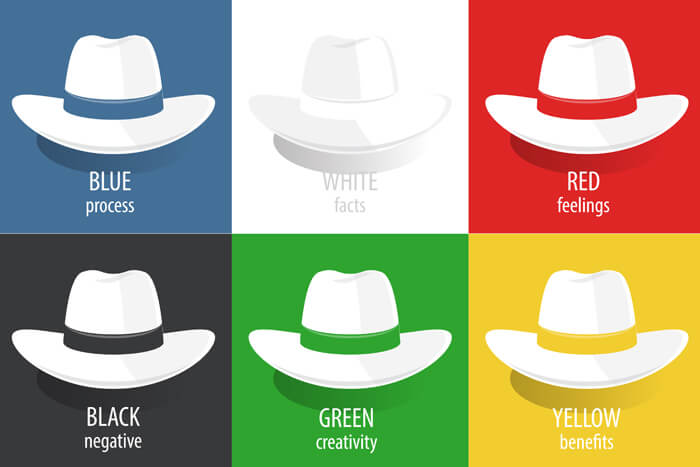
The ‘six thinking hats’ approach is essentially to compel out-of-the box thinking and make analytical decisions. It helps us view a problem or a subject matter from different logical angles or perspectives rather than think in the habitual manner.
The Thinking Hats:
De Bono claimed that “the six thinking hats is a concept that allows thinkers to do one thing at a time. He/she will be able to separate emotion from logic, creativity from information, and so on.”
• The White Hat: The white hat champions a perspective where the assessment or thinking is neutral and objective in manner. The person wearing a white hat focuses on available data and tries to fill gaps in knowledge before a decision
• Red Hat: The assessment is influenced by instinctive reactions, gut feeling, or by emotions. More reactive than active, the person wearing a red hat relates with people emotionally and tries to overwhelm the logic of others using the same tool
• Black Hat: The instinctive assessment of someone wearing a black hat is inherently flawed because it focuses on drawbacks or risks associated with the subject or issue. However, approaching and analyzing a problem wearing a black hat is essential because it focuses on finding out what might fail, and what may not work – thus preempting disaster before it strikes
• Yellow Hat: Positive and optimistic assessment of the situation. This is the best situation for peace of mind and progress, and where you are apt to make the greatest number of mistakes. At any rate, this is the attitude that gets most of the work done.
• Green Hat: Creative and innovative thoughts on the issue. Wearing a green hat, you think only of novel contributions to solve the issue or aid the subject, and never focus from a critical standpoint
• Blue Hat: Organized thinking and control. Essential for managerial thinking the blue hat signifies operational control.
Putting on the Thinking Hats:
The thinking hats are not limited to six, but according to DeBono, the defined six are a good basic to start with in identifying our states of mind or problem solving attitudes.
For really solving a problem or taking an important decision, we need to analyze that decision from the perspective of finding out “what hat had we been wearing when taking that decision?” It also helps to identify the baggage or positive factors that people bring to the table by visualizing or characterizing certain people to be wearing certain hats.
The real use of the thinking hats principle comes in mixing the colors because few people wear the same hat all the time, and fewer conform to rigid stereotypes.
So, as I mentioned in the beginning, people who resist change, but are in managerial positions are most often found wearing ‘purple’ hats, because their thoughts are organized and controlled, but at the same time overcome by illogical emotions. While the concerns like safety, security, viability etc may be correct when raised by a purple hat, what needs to be marked is that the emotions rising out of viable concerns are being illogically imposed.

